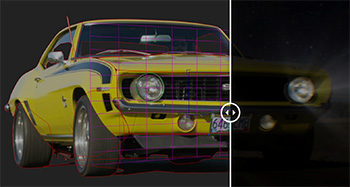Tip #543: What is Planar Tracking?
… for Visual Effects
Tip #543: What is Planar Tracking?
Larry Jordan – LarryJordan.com
Planar tracking solves problems with lost tracking points.


A planar tracker uses planes and textures to track as opposed to points or groups of pixels. This allows the tracker to stay on track even if your shot contains motion blur or a very shallow depth of field. Here’s a quick overview.
Planar tracking was developed by Allan Jaenicke and Philip McLauchlan in the University of Surrey. They founded Imagineer Systems in 2000 to provide commercial applications for this technology.
“Planar Tracking” gains its name from how the system analyzes the source video. It seeks out different ‘planes’, isolating surfaces that can be followed through a shot. The user can define a plane for the computer to follow, and if tracked successfully, the movement of the ‘tracked’ object can be used to drive the motion of newly composited elements, or inversely to stabilize footage within a frame.
Mocha, by Imagineer Systems, is an example of this technology. Once tracking information is derrived from a videoclip within Mocha, it can be used in After Effects to animate the motion of any composited layer. Virtual elements can use this tracking information to control what is essentially a camera move that mimics that of the original shot, so that the virtual and live action elements appear to have been shot by the same camera.
EXTRA CREDIT
While mocha was the first planar tracker, similar technology can be found in:
- Nuke, The Foundry
- Syntheyes, Andersson Technologies
- Flame, Autodesk
- fayIN, fyateq
Learn more from BorisFX, who acquired Imagineer Systems, here.


Leave a Reply
Want to join the discussion?Feel free to contribute!